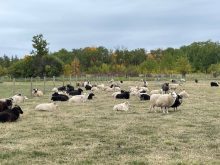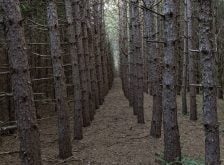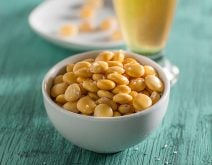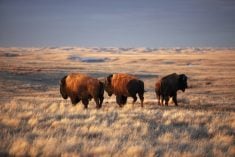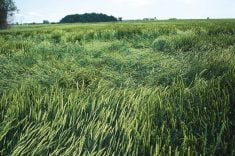Peas as a human and animal feed have been around since 5000 BC. The pea plant, a nitrogen-fixing legume, originated in the cooler areas of the Himalayas and was subsequently cultivated extensively in the Mediterranean basin.
Peas, dried peas in particular, were a major part of the diet in the U.K. in the 19th and early part of the 20th century. Surprisingly to some, the major supplier of dried peas to the U.K. in those years was the province of Ontario. Peas (green types) were grown in Ontario, sometimes staked, were harvested, and exported across the Atlantic. Green boiled mushy peas were a staple diet of the less affluent British.
Read Also

Cancer agency reclassifies another herbicide ‘probably carcinogenic’
The WHO’s cancer research agency has now put atrazine, a herbicide well known to corn growers, in the same potential-hazard category where the agency put glyphosate.
Peas were also played a major part in the dawn of genetics when the Austrian, Gregor Mendel, in the mid-19th century preformed breeding experiments with green and yellow peas and tall and dwarf cultivars.
Peas as a Canadian crop
Why did peas suddenly emerge as a major Canadian crop?
It all began with the discovery by plant breeders in California that they had bred leafless or semi-leafless peas. These peas, unlike the tall lanky or short leafy pea cultivars, could intertwine with each other and stand up in the field or row. In the late 1950s, these leafless peas were acquired by the National Vegetable Research Station at Wellesbourne in the U.K. with great enthusiasm. They immediately put the leafless genotypes to work developing field and table leafless varieties of peas.
In the early 70s I did some work with regular leafy peas while I was at the University of Guelph in Ontario. I used a popular variety called Trapper. Trapper growth and yield had good potential but prior to harvest this leafy pea would lodge badly under field conditions causing most of the pods, peas included, to rot before harvest. Trapper and other leafy peas behaved likewise in my plots on the western Prairies.
By the time the 80s came around the leafless pea varieties arrived in the Prairie provinces and pea production was again off and running in Canada. There seems to be no visible difference between leafless and semi-leafless as far as I can tell.
Now there are dozens of semi-leafless pea varieties, both green and yellow types, all with good to excellent resistance to lodging, the real key to Prairie pea production, something that we now take for granted. In 2018 around five million acres of peas were planted in Western Canada.
Peas, like the rest of the legume family, such as bean, alfalfa, clover, soybean, caragana, peanuts, lupins and legume species often fix some, if not most of their nitrogen requirements. To do this they must be root inoculated with specific species and strains of rhizobic bacteria to effectively fix or manufacture their own nitrogen. There are distinct species of rhizobic bacteria for example for peas and soybeans. In peas and beans specific stains of one species of rhizobia are are better on peas or on faba beans. Other families of plants on the Canadian Prairies also fix nitrogen, such as Russian olive, wolf willow and buffalo berry, but these fix nitrogen in association with actinomycete bacteria. Alder trees, common in the west, also fix nitrogen in association with specific kinds of filamentous actinomycete bacteria.
No added nitrogen needed
The nitrogen-fixing ability of peas, other legumes and non-legumes gives them the ability to out-compete other non-nitrogen fixing plants growing under nitrogen-poor soil conditions. So, applying nitrogen to peas, beans or alfalfa is generally, but not always, a thorough waste of time and money. You could call it “gilding the lily.”
Dry peas, on average are 25 per cent by weight protein or four per cent nitrogen. When they germinate in nitrogen-deficient soils in the presence of suitable rhizobia species, the pea roots very quickly allow the rhizobial bacteria to invade the roots to form root nodules. If soils are high in nitrogen, the pea roots will reject the nodule-forming rhizobia and take up the free nitrogen. Free nitrogen also means lots of weeds also picking up this available nitrogen.
In nature, peas and all other nitrogen-fixing plant species, particularly legumes in agriculture, have this giant advantage in nitrogen-deficient soils. Nitrogen-fixing peas can grow rapidly with their own nitrogen-fixing supply, while the competing weeds are nitrogen starved. Therefore, all legumes should be planted on your most nitrogen-deficient cropland, and please resist the temptation to add nitrogen. Do not waste money!
Seed and fertilizer
Peas can be seeded early in the season in mid-April to May when the soil temperature in the top two inches (5 cm) reaches 4 C. They grow best in moist, well-drained soils and do poorly in wet water-logged soils. Recommended inoculum should be added during the pea seeding process, preferably in pelletized peat. Ensure that the rhizobial bacteria are fresh and viable. Most soils contain wild rhizobia but not usually in sufficient quantity to optimally inoculate the roots of the pea crop. Nitrogen fixation by peas is a high energy consuming process by the plant, needing lots of photosynthetic sugar to fix the nitrogen.
In addition to the sugars needed in the root nodule by the bacteria, the nodules need phosphate, cobalt, iron, molybdenum, manganese and zinc to accomplish this process. Pink interiors of the healthy nitrogen-fixing nodules indicate the presence of leghaemoglobin, a relative of blood haemoglobin in animals.
Pea plants are very good scavengers of soil nutrients and, unlike wheat or flax, rarely suffer from micronutrient deficiency. As far as macronutrients are concerned, peas can pick up enough phosphorus in soils considered to be deficient for wheat or canola. Nonetheless, peas cropland should have good to adequate levels of phosphorus, potassium, and sulphur very low to minimal levels of nitrogen. Nitrogen levels below 10 or 15 pounds per acre would be most suitable.
A 50-bushel pea crop should produce most of the 150 pounds of the nitrogen it requires via the root nodules but it also needs over 40 lbs. of P, 140 lbs. of K and 15 lbs. of available S. Growers should also ensure that the pea cropland is free from soil residues of atrazine, clopyralid and flucarbazone highly damaging to the pea crop.
Diseases of Peas
In the last 30 or so years pea breeders have given us excellent crop stability with leafless varieties, powdery mildew resistance, fusarium wilt resistance, and moderate to early maturity. Mycosphaerella blight is a major problem but problems with sclerotinia, seedling root rots, septoria blotch, downy mildew and bacterial blight also occur. All of these diseases including pink seed, brown spot and virus diseases can be managed.
The big exception: aphanomyces root rot. This root rotting soil-borne fungus disease has previously wiped out peas-growing industries in France, New Zealand and Wisconsin in the United States.
Aphanomyces euteiches is a soil-borne resting spore, forming zoospores that are highly destructive to legumes and pulse crops particularly in wet or waterlogged soils. Stains of this fungus affect a wide range of legumes including peas, beans, faba beans, lentils and alfalfa to name a few.
This destructive root rot disease can best be described as the “clubroot disease of peas.” It’s OK if you disagree with me — I cannot force you to be right.




